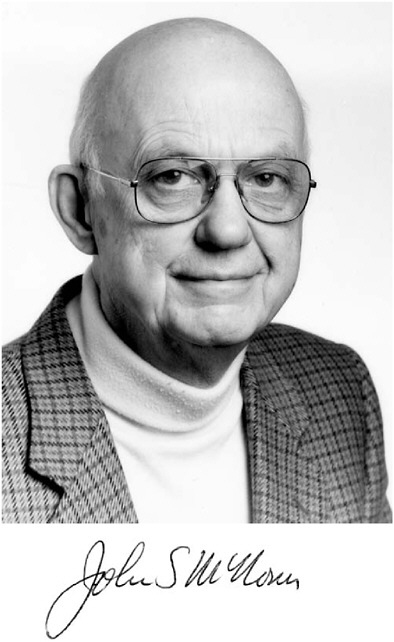JOHN S. MCNOWN
1916–1998
Elected in 1987
“For outstanding contributions to the application of fluid mechanics, and for exceptional professional leadership in advancing engineering education in Africa.”
BY ROSS E. MCKINNEY
JOHN S. MCNOWN, former dean of engineering and Emeritus Professor of Civil Engineering at the University of Kansas (KU), died on February 19, 1998.
John was born on January 15, 1916, in Lawrence, Kansas, a short walk from the KU campus. His father, W.C. McNown, was a professor of civil engineering, and John grew up in an academic engineering environment. After graduating from Lawrence High School, John entered the School of Engineering at KU, where he developed an interest in hydraulic engineering. After receiving his B.S. in civil engineering in 1936, he continued his studies at the University of Iowa and received his M.S. in hydraulic engineering in 1937. He then moved to the University of Minnesota, where he was an instructor and doctoral student. He received his Ph.D. in hydraulic engineering from the University of Minnesota in 1942.
After working for a year as a research associate at the University of California on war-related projects, he joined the faculty of the University of Iowa as an assistant professor of mechanics and hydraulics and associate director of the Institute of Hydraulic Research. While at Iowa, he worked with Hunter Rouse. In 1950, on a Fulbright Fellowship, John studied and conducted research in Grenoble, France. After a very productive year there, he received a D.Sc. from the University of Grenoble. During that year, he also refined and modified his approach to engineering education.
John then returned to the University of Iowa, where he remained until 1954, when he left to become a professor of engineering mechanics at the University of Michigan. In 1957, after only three years at Michigan, he was asked to become dean of engineering at KU by Chancellor Franklin Murphy, whose ideas for modernizing engineering education dovetailed with John’s. Unfortunately, because of differences of opinion between Chancellor Murphy and Kansas Governor George Docking, Murphy resigned in 1960, just as progress was beginning to show. The new chancellor, Clarke Wescoe, did not have the same vision for the School of Engineering.
John wanted to create a first-class engineering research facility at KU that would not be hampered by bureaucratic red tape. In 1962, he was instrumental in the creation of the Center for Research in Engineering Sciences (CRES) in the Center for Research, Incorporated. However, frustrated with the rate of development of engineering research and change in engineering education, he resigned as dean of engineering in 1965 and rejoined the faculty as the Albert P. Learned Professor of Civil Engineering.
Based on his experience as an administrator, John then turned his attention to international engineering education, especially in Africa, where he recognized that well-educated engineers could help raise the standard of living for millions of people. In 1973, John married a Swedish national, Eva Fernqvist, and began to split his time between the United States and Sweden. He became an expert in international engineering education, and, in 1983, he retired from KU and moved to Sweden.
Hydraulic research was John’s passion, and teaching was his family heritage. The American Society of Civil Engineers recognized the value of John’s research by awarding him the J.C. Stevens Prize in 1946, Walter L. Huber Engineering Research Prize in 1949, and J. James R. Croes Medal in 1955. As a dean of engineering, John was asked to serve on an advisory panel for the National Science Foundation (1957–1960) and the Engineers Council for Professional Development (1960–1965). In 1967, he became a member of the Overseas Liaison Committee for the American Council on Education in both Nairobi and Washing-
ton, D.C. In 1972, the World Bank retained John as a technical education specialist. He was a consultant on hydraulic engineering to the Swaziland Ministry of Agriculture in 1981 and a resident consultant for the Tunisia Ministry of Higher Education and Scientific Research in 1982. The next year, John became a visiting professor at the Royal Institute of Technology in Stockholm, Sweden.
John’s ideas about university administration at all levels were influenced by his growing up in an engineering faculty family during the 1920s and 1930s. Eventually, he took his ideas for reforming engineering education, and engineering as a whole, to Washington, where he convinced many government agencies to incorporate them into plans to improve engineering education in Africa to meet the needs of the peoples of Africa.
In recognition of John McNown’s contributions to fluid mechanics and international engineering education in Africa, he was elected a member of the National Academy of Engineering in 1987. In 1989, KU honored him with the Distinguished Engineering Service Award in recognition of his lifetime contributions to engineering education and research.





